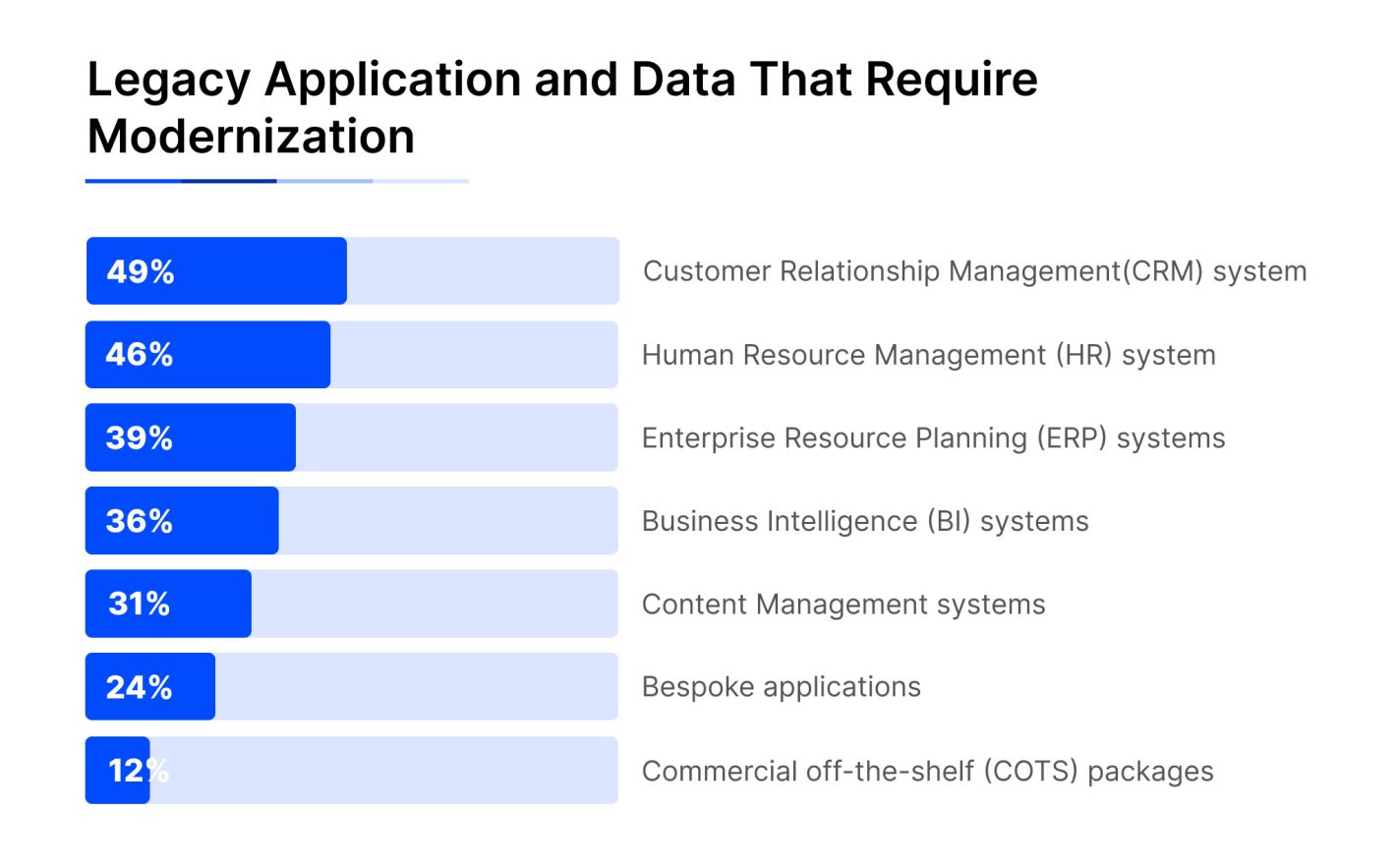Leading a global organization today is more difficult than ever. On the one hand, we’re still experiencing the aftermath of the COVID-19 pandemic; on the other hand – recession, growing geopolitical tensions, and cybersecurity disruptions put business leaders under pressure.
Furthermore, data indicates that merely enjoying the benefits of a successful product will not suffice in the long term. In our previous blog, we noted that legacy systems will become hopelessly outdated in 2025. Today, according to Dell, the number of companies running on old systems in the Fortune 5000 list alone is over 70%.
Having such conditions, it is quite logical that companies resort to the most obvious solution to the problem – modernization. But…
79% of them fail in this endeavor.
In this article, we will discuss what to do to avoid joining this sad statistic. To give you a clue, it’s application modernization strategy.
The Business Need for Software Modernization Strategy in 2025
Back in the day, executives would have just gathered all the statistics and the need for technical modernization of outdated software and passed it to IT specialists and let them deal with it. However, today, technology has become so integrated into business processes that it is impossible to start modernization without involving all stakeholders and understanding why you need it. There are several reasons for this today:

Demand for personalized, digital customer experience
According to a State of Customer Service and CX Study, 81% of customers prefer companies that offer a personalized experience.
Seventy percent say they value a customized experience in which the employee knows who they are and their history with the company (past purchases, buying patterns, support calls, and more).
The demand for personalized, seamless digital experiences will continue to push companies in the years to come to modernize applications to meet evolving customer expectations.
Support of distributed workplaces
It depends on your company’s vision and long-term strategy. However, having a global team or scaling will require better employee collaboration while visiting clients or attending conferences. Accessing necessary assets, documentation, etc., and responding to an ad hoc request quickly at the airport or elsewhere – is a positive thing for businesses. Also, to support the claim, let’s not forget the number of employees working in hybrid or fully remote arrangements grew from 15% in 2023 to 38% in 2024.
Companies will modernize existing applications to support distributed workplaces through cloud-based, collaborative, and secure applications.
Meeting regulatory compliance
Let’s just say you’d better get ready.
As Amy Matsuo, Regulatory Insights Leader, KPMG LLP, put it:
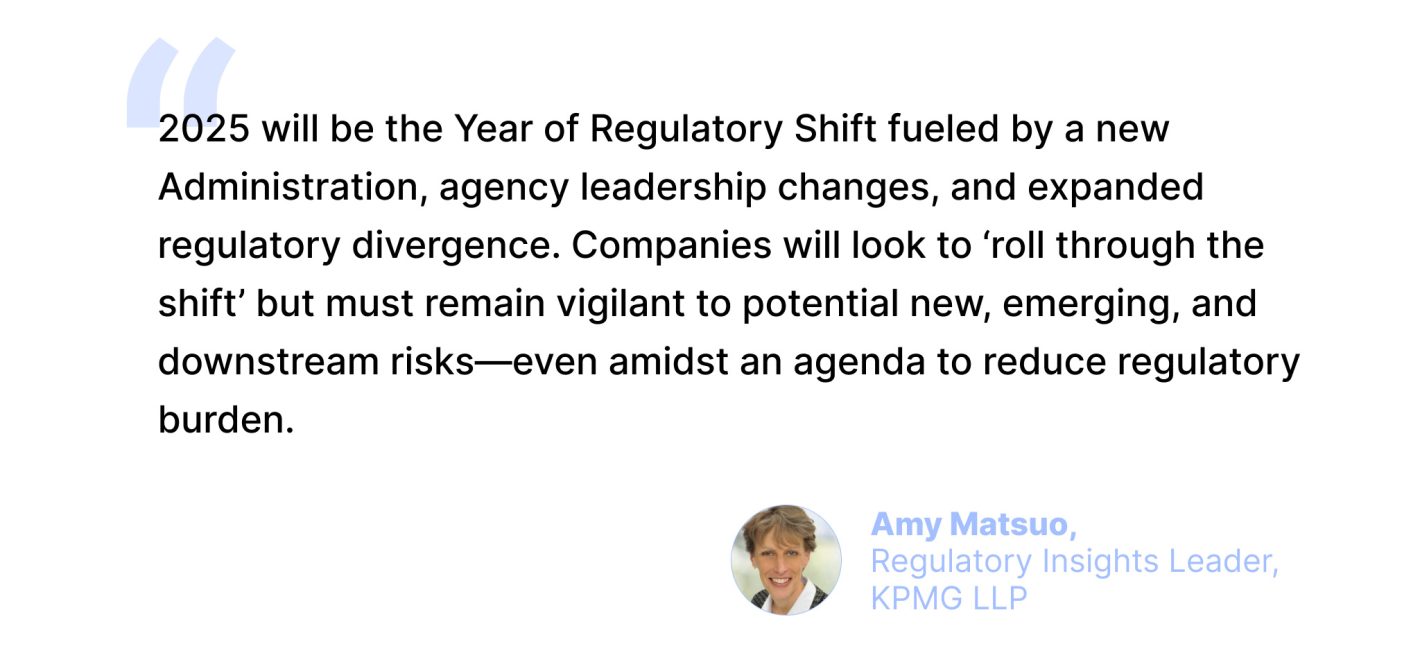
Such a shift will definitely make the application modernization process more urgent to meet new security, privacy, and compliance standards.
Rising operational costs
Supporting legacy software systems isn’t going to get easier in the years to come. How futureproof do you think COBOL is? How easy will it be to find a knowledgeable COBOL expert? They are retiring. Scarcity will be skyrocketing your budgets. Rising operational costs make modernization appealing as businesses seek to optimize resources and reduce technical debt.
Moreover, a legacy application modernization strategy(when done right, of course) can help reduce maintenance and operational costs by up to 50%.
The need for real-time insights and analytics
At this point, it’d be fair to say everything is connected. Faster data reporting and analysis are major challenges in many companies. According to the ‘Data, BI & Analytics Trend Monitor 2022’ survey, there is an increasing need to make data from transactional systems available immediately to support faster, fact-based operational decision-making. This need drives businesses to modernize applications for improved data accessibility and analysis, enabling innovative ways of doing business and allowing teams to take action.
Adopting state-of-the-art technologies
Legacy software systems can become unexpected bottlenecks in realizing a company’s AI ambitions or other technological advancements, like generative AI, multi-cloud and hybrid environments, containerization, serverless architectures, edge computing, and more. These technologies require modern technology foundations.
As our CTO, Yurii Nakonechnyi, put it, you should identify the problem first and then apply the latest shiny technology.
And one last thing: out-of-date software prevents your ability to adapt to changing market demands. McKinsey surveyed top tech executives in the US and found that companies embracing digital transformation achieve much bigger revenue growth than their less agile counterparts.
Now that you understand the trends driving application modernization, you need to know how to succeed.
Steps to Successful Application Modernization
Having answered the ‘Why’, let’s move on to the ‘How.’
With 92% of a vFunction survey respondents claiming they are planning to or have already started their app modernization projects, we want to talk about how to get into that 21% whose application modernization project doesn’t fail.
So, how do you craft a successful app modernization strategy?

Four steps to app modernization
Step 1. Assess the current state of the application
On average, an organization has 22 systems/applications in use, and only half can be modernized.
It means that you need to start by auditing your existing applications, identifying legacy systems or legacy system parts, estimating maintenance costs, and defining your modernization goals.
Step 2. Choosing the Right Modernization Path
Next, you need to understand the different legacy modernization approaches and make a choice based on your business objectives and goals from step 1.
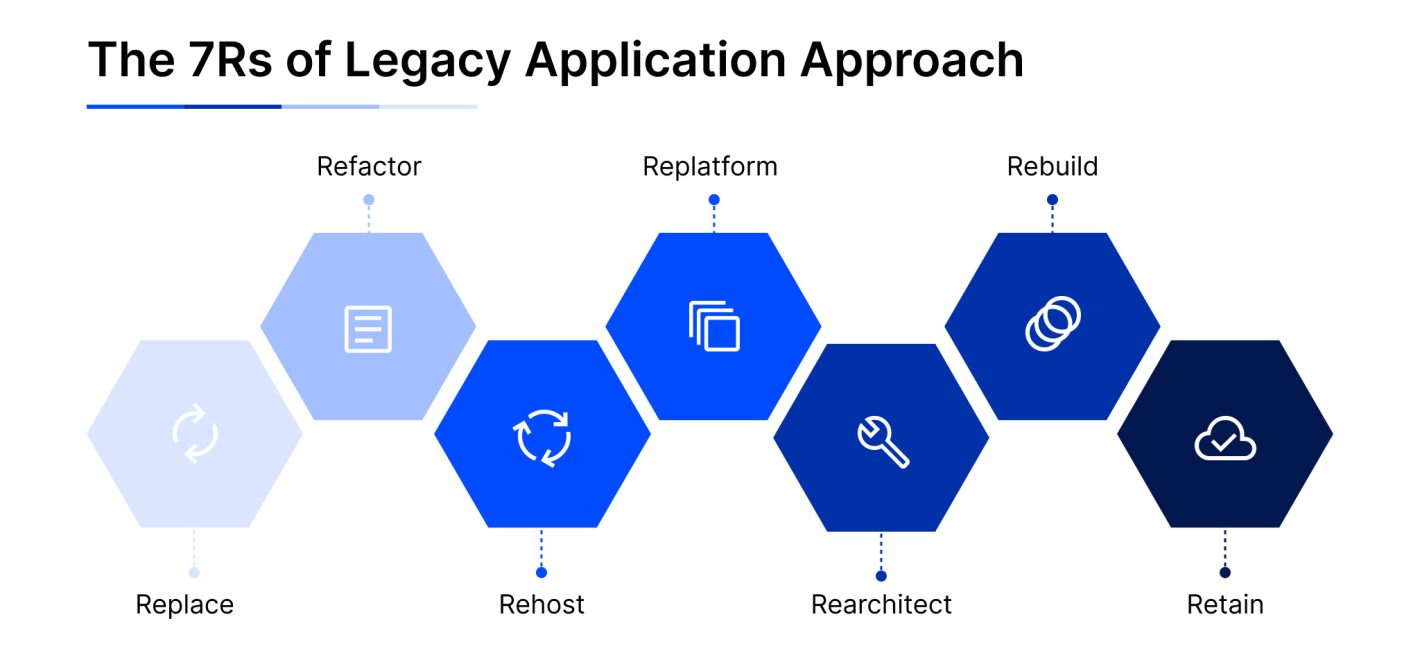
Seven application modernization approaches
There are seven common options for technology modernization strategy:
- Replacing. This approach intends to replace the former application completely.
Use case: the technical limitations you’ve discovered can not be fixed by any amount of app modernization effort. - Refactoring. The method is focused on optimizing or rewriting the existing code.
Use case: the primary assessment showed you’ve collected a significant technical debt and aim to improve operation performance. The existing app’s functionality remains untouched. - Rehosting. What you do here is your organization rehosts the application, moving it to a different infrastructure, be it physical, virtual, or cloud.
Use case: Since digital transformation strategies require fast cloud migration, retaining service uptime with minimal disruption is a good option. - Replatforming. A similar option to rehosting when you change one technical stack to a new one. The code structure, features, and functions cannot be altered.
Use case: moving a website from Microsoft Azure to AWS for better cost-efficiency. - Rearchitecting. Redesigning a new application architecture and rewriting the code to fit with it.
Use case: Often used for monolithic applications. - Rebuilding. Gradually redesign or rewrite the application component from scratch while preserving its scope and specifications.
Use case: First, a critical component is written and deployed, the others are slowly rebuilt until the application is fully modernized. - Retaining. Make no changes and keep the application in its current state as long as it delivers value and meets compliance requirements. While we believe it is not a preferred strategy for legacy applications, it is understandable that sometimes that’s what is necessary.
Use case: your company does not have the budget or prioritizes other strategies for the years to come.
Step 3. Setting Up a Phased Application Modernization Roadmap and Funding Scheme
Establishing phases for migration, testing, and scaling to ensure smooth transitions.
The next step is to obtain executive sponsorship for project funding. With all the data you’ve acquired, determining the budget for the modernization initiative will be easier.
Here’s an example of the application modernization roadmap we use at Sombra in our projects:
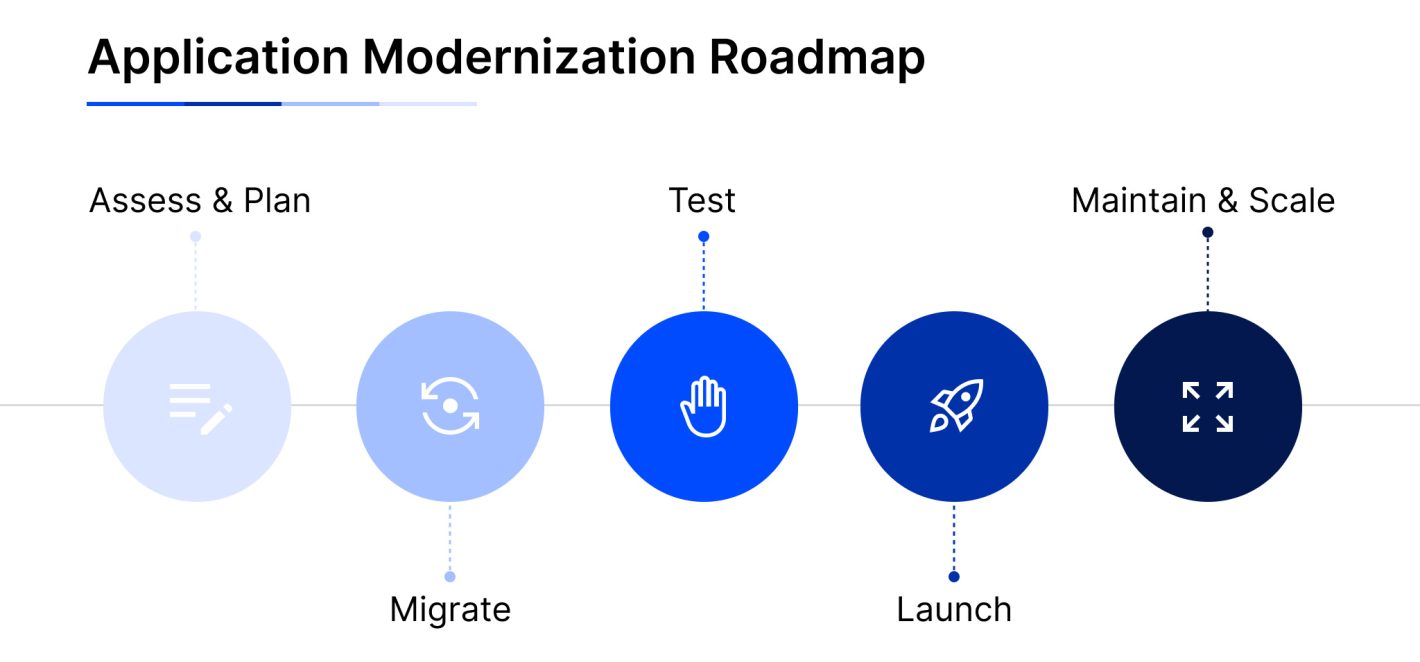
Sombra’s application modernization roadmap
Step 4. Define Success Metrics and Monitoring Strategies
You need to measure the impact of app modernization. Therefore, you have to identify the success indicators for the project. Those can be:
- Performance
- Cost savings
- Speed of delivery
You should also determine the return on investment (ROI) and total cost of ownership (TCO) to show the value that application modernization will bring to the company. For us at Sombra, it’s crucial to focus on business results and ROI in all projects we’re doing for our Customers. Thus, not only for Clients it’s important to measure all this, but also our Team is deeply involved and focused on those results.
Find the Right Modernization Partner
In theory, and our article so far, everything looks quite simple, but even dozens of white papers will not be enough to describe all the processes. As a company that has helped dozens of clients create and navigate an application modernization strategy, we assure you that the path will be much easier with a reliable partner.
We take a DONE RIGHT application modernization approach, which includes:
- Assessing your legacy systems.
- Helping you plan, organize, and implement an application modernization roadmap for tailored recommendations.
- Developing a strategy for continuous app improvements.
Depending on the situation and complexity of the modernization project, we adjust this approach to ensure we meet your business objectives and really transform your challenges into success stories on time and within budget.
What to Avoid When Building an App Modernization Strategy
Having talked about the steps to succeed, we must mention what could make your app modernization strategies pointless.
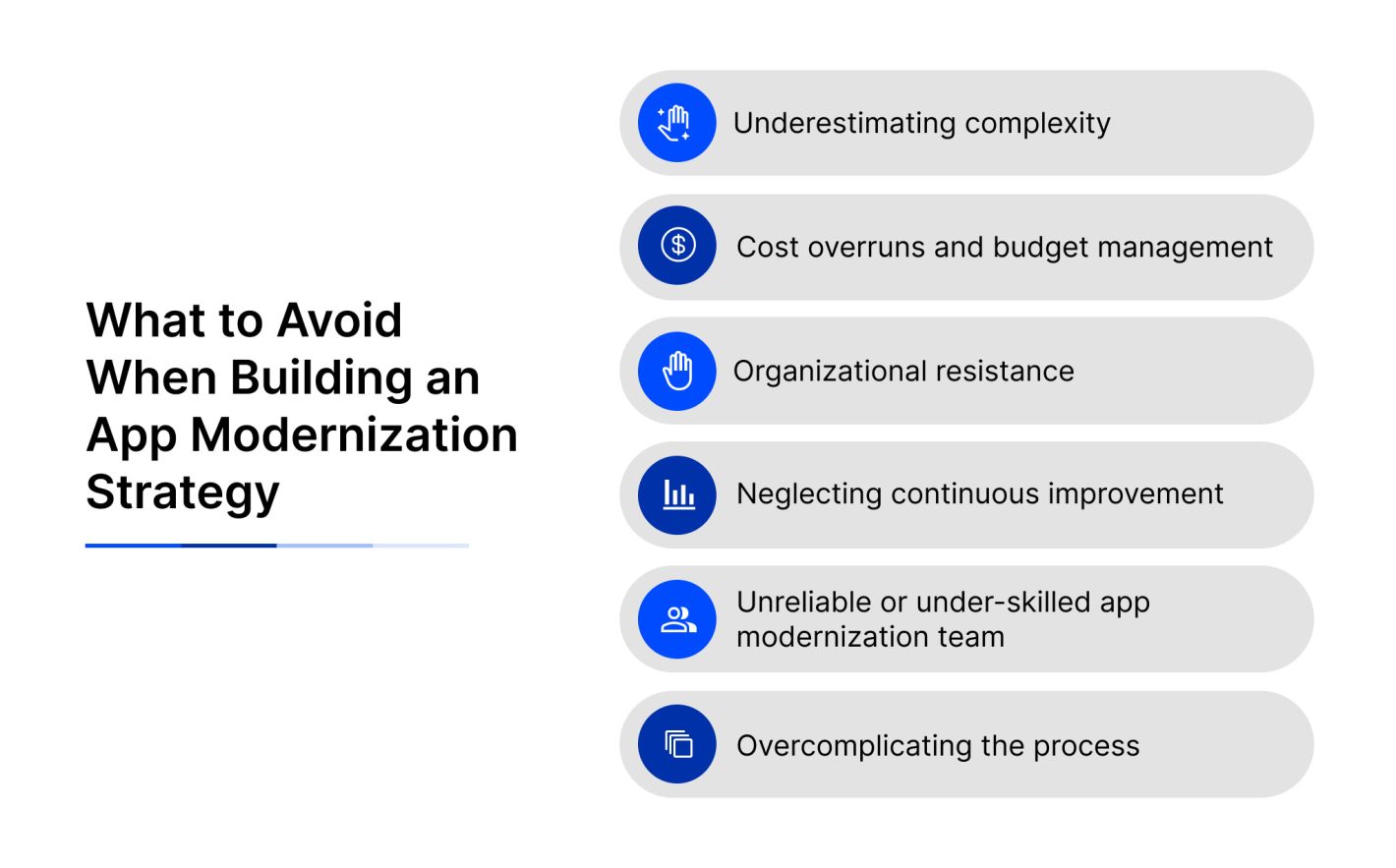
Six things to avoid when building an application modernization strategy
- Underestimating complexity
Recognize and prepare for the potential challenges with legacy systems and dependencies to avoid setbacks. - Cost overruns and budget management
Balance the budget with strategic priorities and establish contingency plans to manage unexpected costs. - Organizational resistance
Handle resistance to change by fostering a culture of innovation and providing comprehensive training and support. - Neglecting continuous improvement
Consider modernization as an ongoing process rather than a one-time project to ensure long-term success. - Unreliable or under-skilled app modernization team
Choose only reliable internal teams, external teams, or vendors with significant expertise in app modernization to avoid derailing efforts. - Overcomplicating the process:
Carefully select tools, technologies, and processes to avoid overwhelming teams with steep learning curves or inefficiencies.
Following Best Practices of Application Modernization Project with Sombra
One of our clients, an American Flooring Company, contacted Sombra for assistance with modernizing its enterprise resource planning system (ERP). The client had its employees manually convert handwriting into digital, which increased the application’s maintenance numbers and led to data mistakes.
The client decided to go paperless and engaged Sombra experts to assist in ERP modernization. The team utilized the best practices in application modernization to upgrade a 30-year-old software system.
The team inherited Java-based software from the previous vendor and developed the application modernization strategy. We also considered that the system was closely integrated with accounting, CRM, and other third-party systems.
Having followed the five steps of a successful app modernization strategy, we managed to
- Modernize the inherited technology stack with up-to-date solutions.
- Change and implement new features according to the client’s business processes.
- Run software production support.
Eventually, modernized ERP helped the client improve their business efficiency and streamline data management, which led to better decision-making and enhanced business performance.
To read the full story, click here.

Conclusion
In 2025, unless you are a startup or have already gone through legacy software modernization, the topic of strategizing application modernization will come up for you here and there, because it is a trending topic. And most importantly, unlike shiny new technologies, it’s something that people don’t like to do, but it’s necessary. Like a vaccine for the health of a business. It’s better to get a vaccine when you need it.
At Sombra, we believe every technical challenge holds an opportunity for transformation. Combining a customized approach, proven expertise, and a focus on your unique goals, we turn complex modernization projects into success stories. From improving performance and scalability to reducing costs and time-to-market, the right application modernization strategy delivers tangible results for your business today and prepares you for tomorrow.
Don’t let outdated systems hold you back. Contact us to navigate your modernization journey with confidence and clarity. Together, we will transform your legacy systems into a foundation for growth, innovation, and long-term success.


